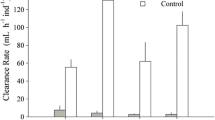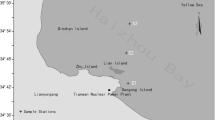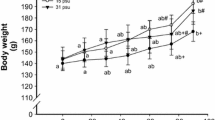Abstract
Matsushima Bay, one of the richest oyster-culture areas in Japan, is subject to heavy artificial eutrophication, mainly from the inflow of city and factory sewages. The physiological activity in the oyster Crassostrea gigas in hanging cultures (i.e., suspended in wire-mesh cages) in this embayment declines markedly with progressive development of the gonads; this decline in activity coincides with eutrophication-induced accumulation of fatty material in the epithelia of the digestive organs; the oyster is thereby forced to depend on these accumulated fats for respiratory substrates in order to maintain its increased physiological needs. However, the fats are inefficient energy sources for the oyster and hence, during each spawning season, 50% mortality occurs. In addition, such phenomena as overmaturation of the gonad and disturbance of the lipid and steroid metabolism seem to accelerate this mass mortality. On the basis of the results, the author has compiled a schematic diagram which illustrates the possible causes of mass mortality among C. gigas in an eutrophic environment such as Matsushima Bay.
Similar content being viewed by others
Literature cited
Chalkley, H.W.: Method for the quantitative morphologic analysis of tissues. J. natn. Cancer Inst. 4, 47–53 (1943)
Imai, T., K. Numachi, J. Oizumi and S. Sato: Studies on the mass mortality of the oyster in Matsushima Bay. II. Search for the cause of mass mortality and the possibility to prevent it by transplantation experiment. Bull. Tohoku reg. Fish. Res. Lab. (Shiogama, Miyagi Prefecture, Japan) 25, 27–38 (1965)
Kan-no, H., M. Sasaki, Y. Sakurai, T. Watanabe and K. Suzuki: Studies on the mass mortality of the oyster in Matsushima Bay. I. General aspects of the mass mortality of the oyster in Matsushima Bay and its environmental conditions. Bull. Tohoku reg. Fish. Res. Lab. (Shiogama, Miyagi Prefecture, Japan) 25, 1–26 (1965)
Kemp, A. and A.J.M. Kits van Heijningen: A colorimetric micromethod for the determination of glycogen in tissues. Biochem. J. 56, 646–648 (1954)
Lison, L.: Histochimie et cytochimie animales, principes et methodes [in Japanese, transl. by T. Imaizumi], 773 pp. Tokyo: Hakusuisha 1962
Mori, K.: Histochemical study on the localization and physiological significance of glucose-6-phosphate dehydrogenase system in the oyster during the stages of sexual maturation and spawning. Tohoku J. agric. Res. 17, 287–301 (1967)
—: Changes of oxygen consumption and respiratory quotient in the tissues of oysters during the stages of sexual maturation and spawning. Tohoku J. agric. Res. 19, 136–143 (1968)
T. Imai, K. Toyoshima and I. Usuki: Studies on the mass mortality of the oyster in Matsushima Bay. IV. Changes in the physiological activity and the glycogen content of the oyster during the stages of sexual maturation and spawning. Bull. Tohoku reg. Fish. Res. Lab. (Shiogama, Miyagi Prefecture, Japan) 25, 49–63 (1965a)
—, H. Tamate and T. Imai: Histochemical study on the change of 17β-hydroxysteroid dehydrogenase activity in the oyster during the stages of sexual maturation and spawning. Tohoku J. agric. Res. 17, 179–191 (1966)
——— and O. Itikawa: Studies on the mass mortality of the oyster in Matsushima Bay. V. Changes in the metabolism of lipids and glycogen of the oyster during the stages of sexual maturation and spawning. Bull. Tohoku reg. Fish. Res. Lab. (Shiogama, Miyagi Prefecture, Japan) 25, 65–88 (1965b)
Nomura, S. and G. Tomita: A simple method of measuring the mechanical activity of cilia. J. Shanghai Sci. Inst. (Sec. 4) 1 (3), 29–39 (1933)
Okamoto, K., M. Ueda and R. Maeda: Kenbikyoteki soshikikagaku [Microscopic histochemistry], 592 pp. Tokyo: Igaku-Shoin 1958
Tamate, H., K. Numachi, K. Mori, O. Itikawa and T. Imai: Studies on the mass mortality of the oyster in Matsushima Bay. VI. Pathological studies. Bull. Tohoku reg. Fish. Res. Lab. (Shiogama, Miyagi Prefecture, Japan) 25, 89–104 (1965)
Tomita, G.: On the Nomura and Tomita method for measuring the mechanical activity of cilia. Bull. mar. biol. Stn Asamushi 7, 157–167 (1955)
Author information
Authors and Affiliations
Additional information
Communicated by M. Anraku, Nagasaki
Rights and permissions
About this article
Cite this article
Mori, K. Effects of artificial eutrophication on the metabolism of the Japanese oyster Crassostrea gigas . Marine Biology 53, 361–369 (1979). https://doi.org/10.1007/BF00391619
Accepted:
Issue Date:
DOI: https://doi.org/10.1007/BF00391619




